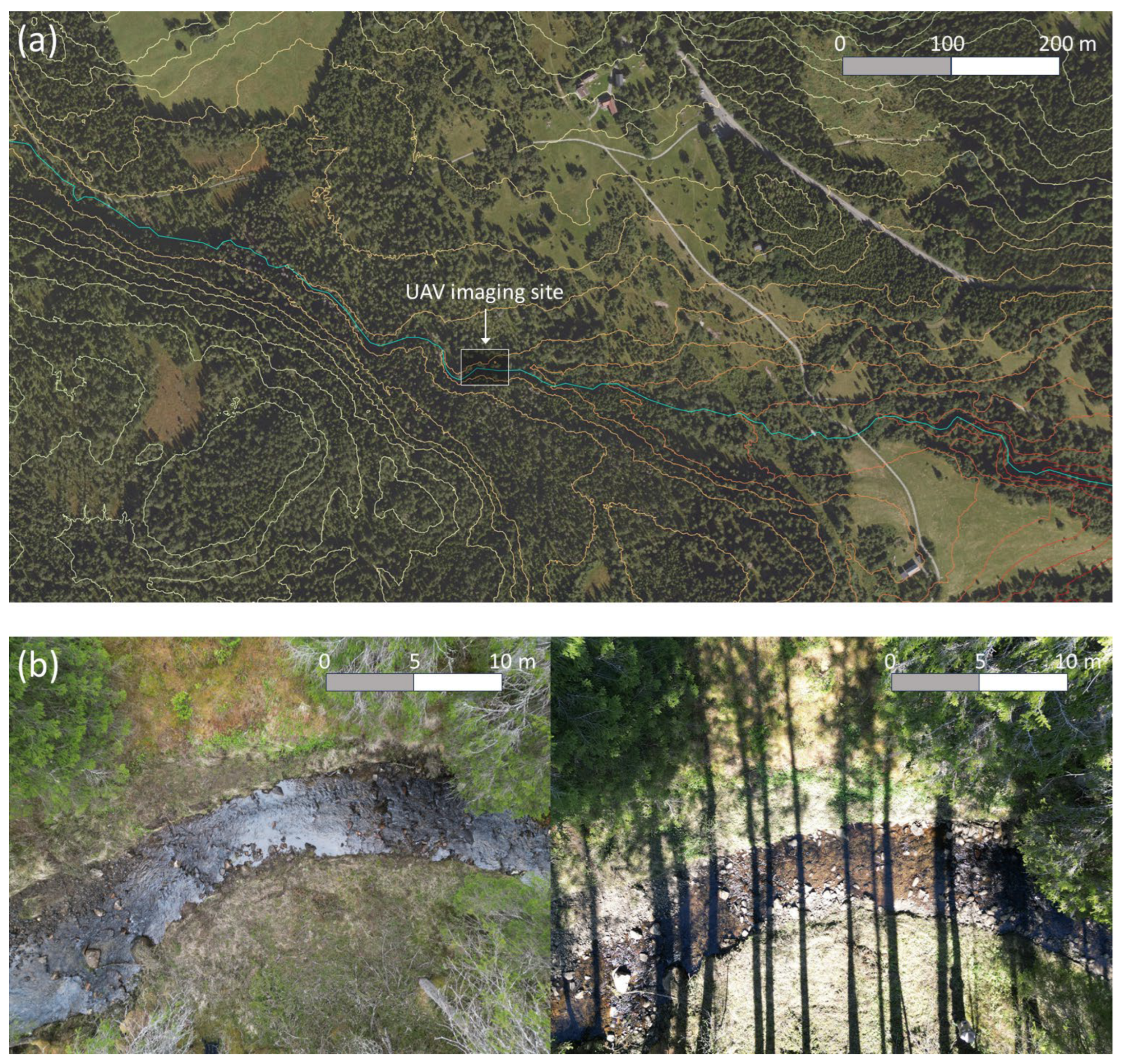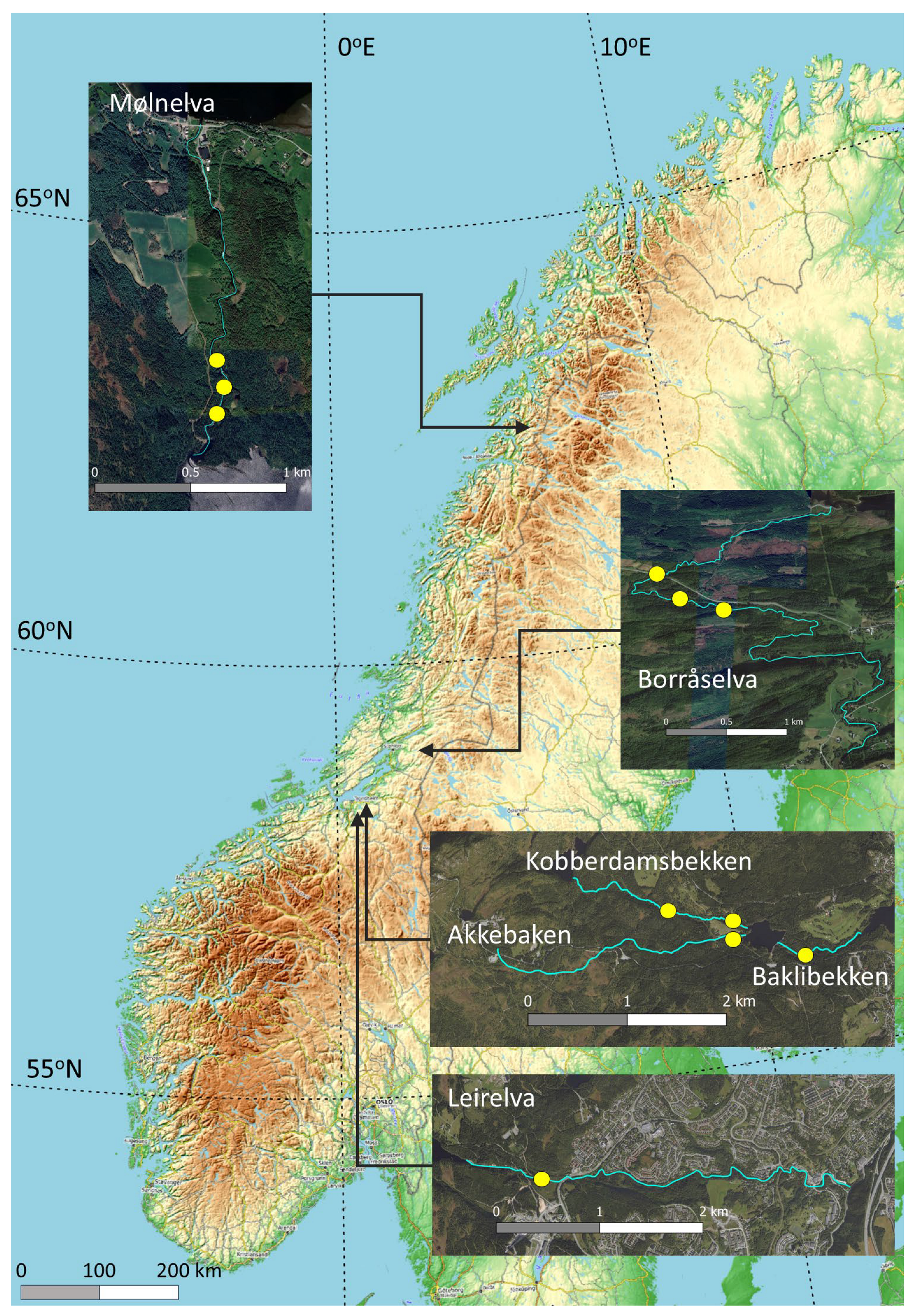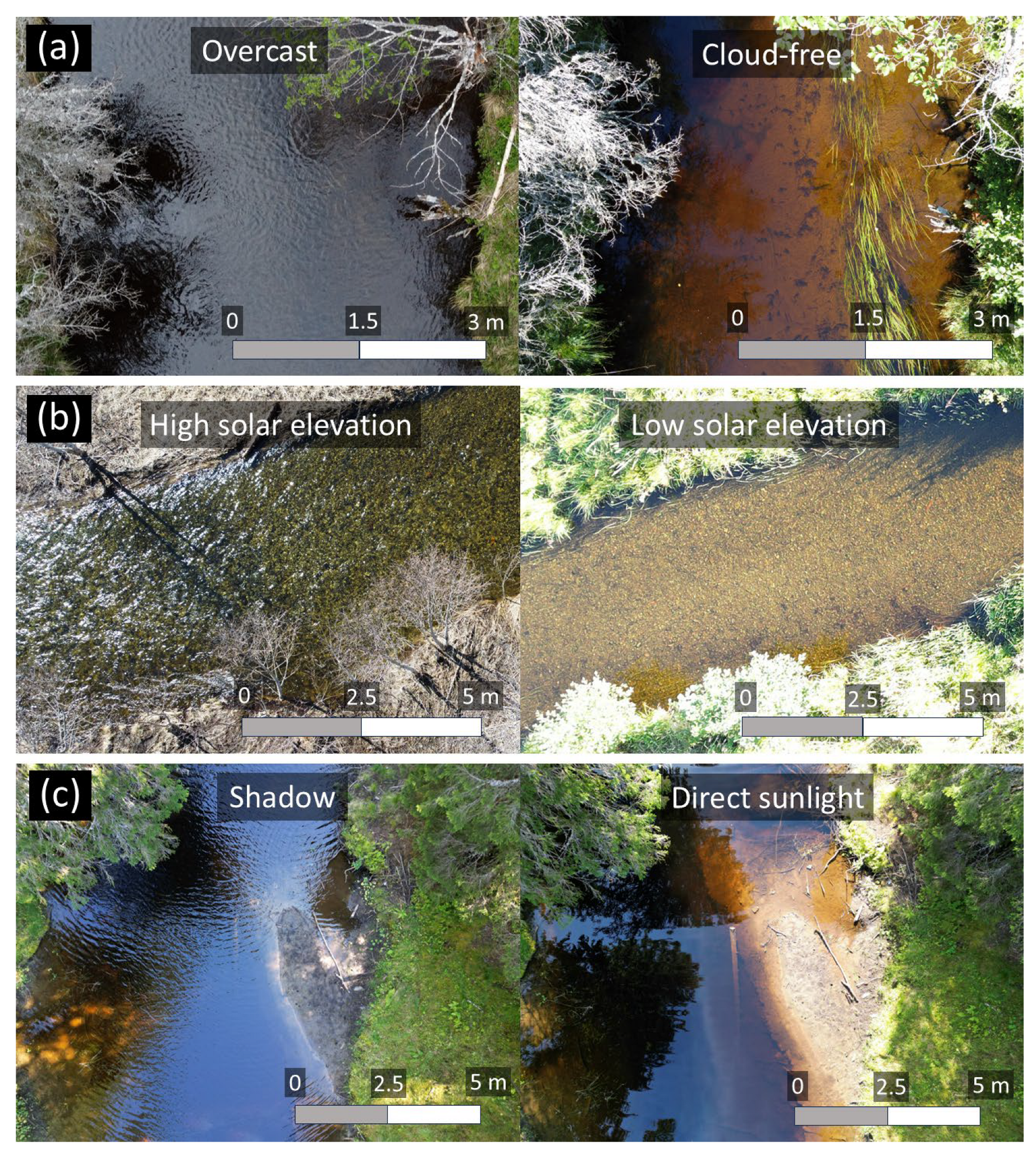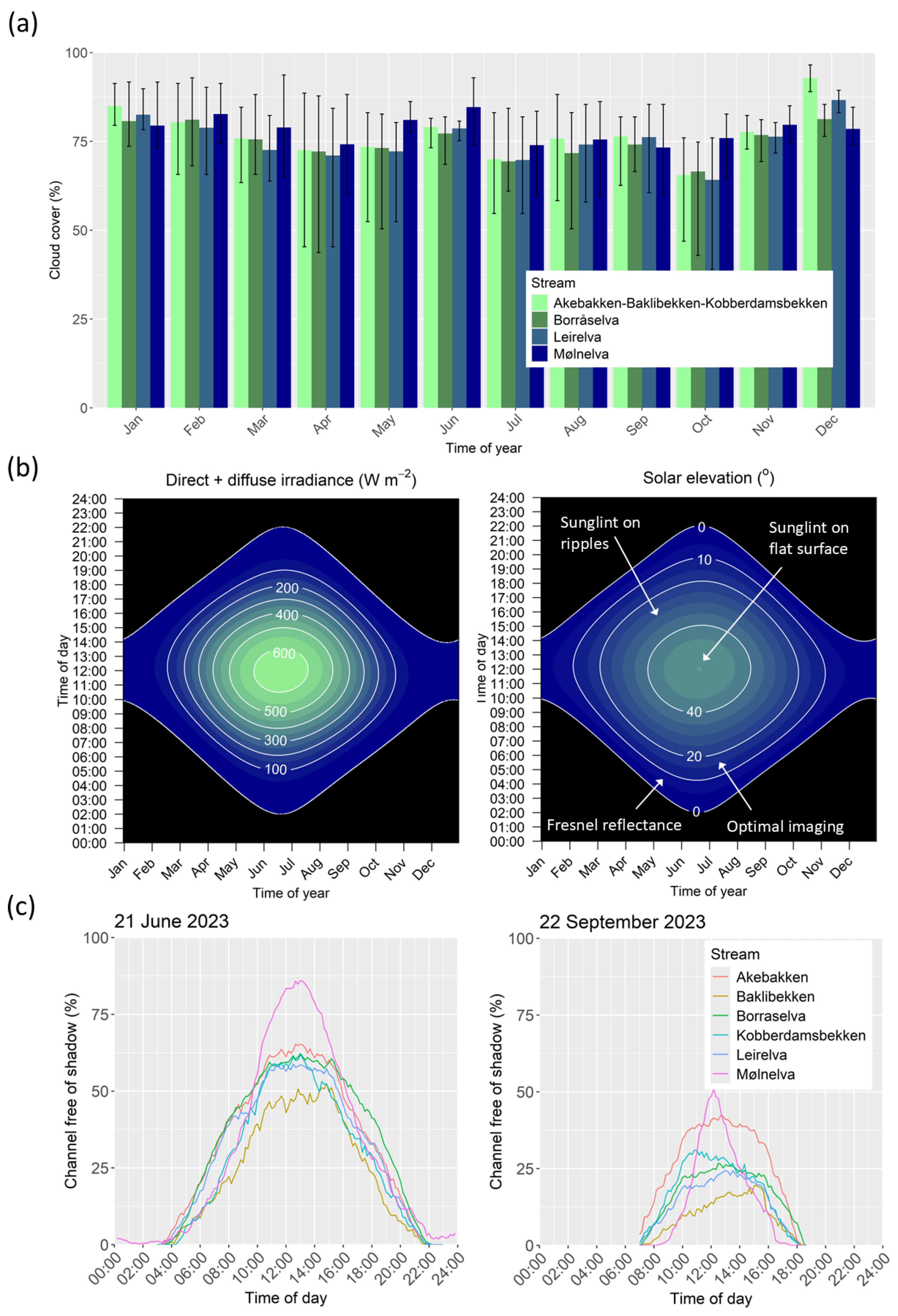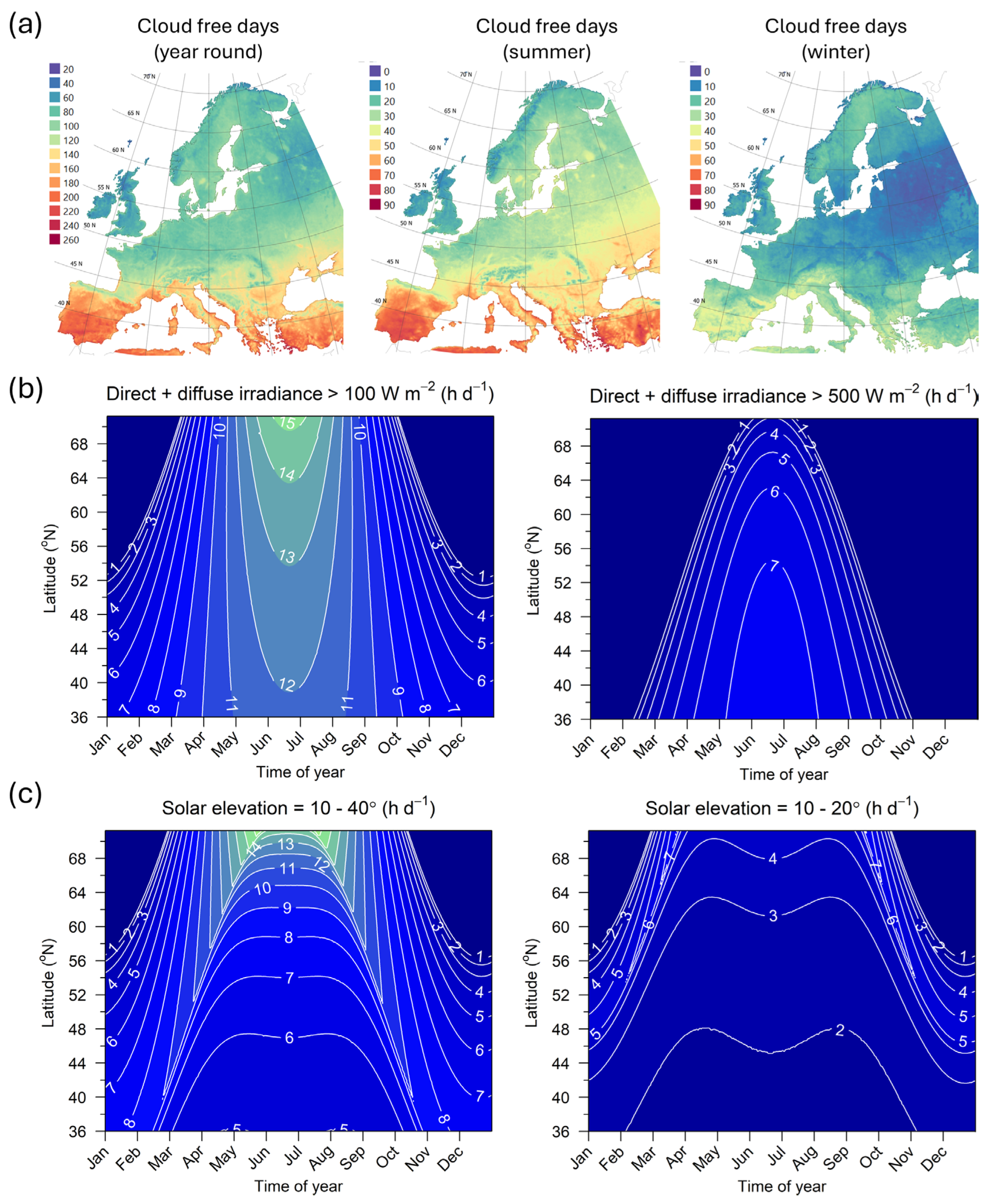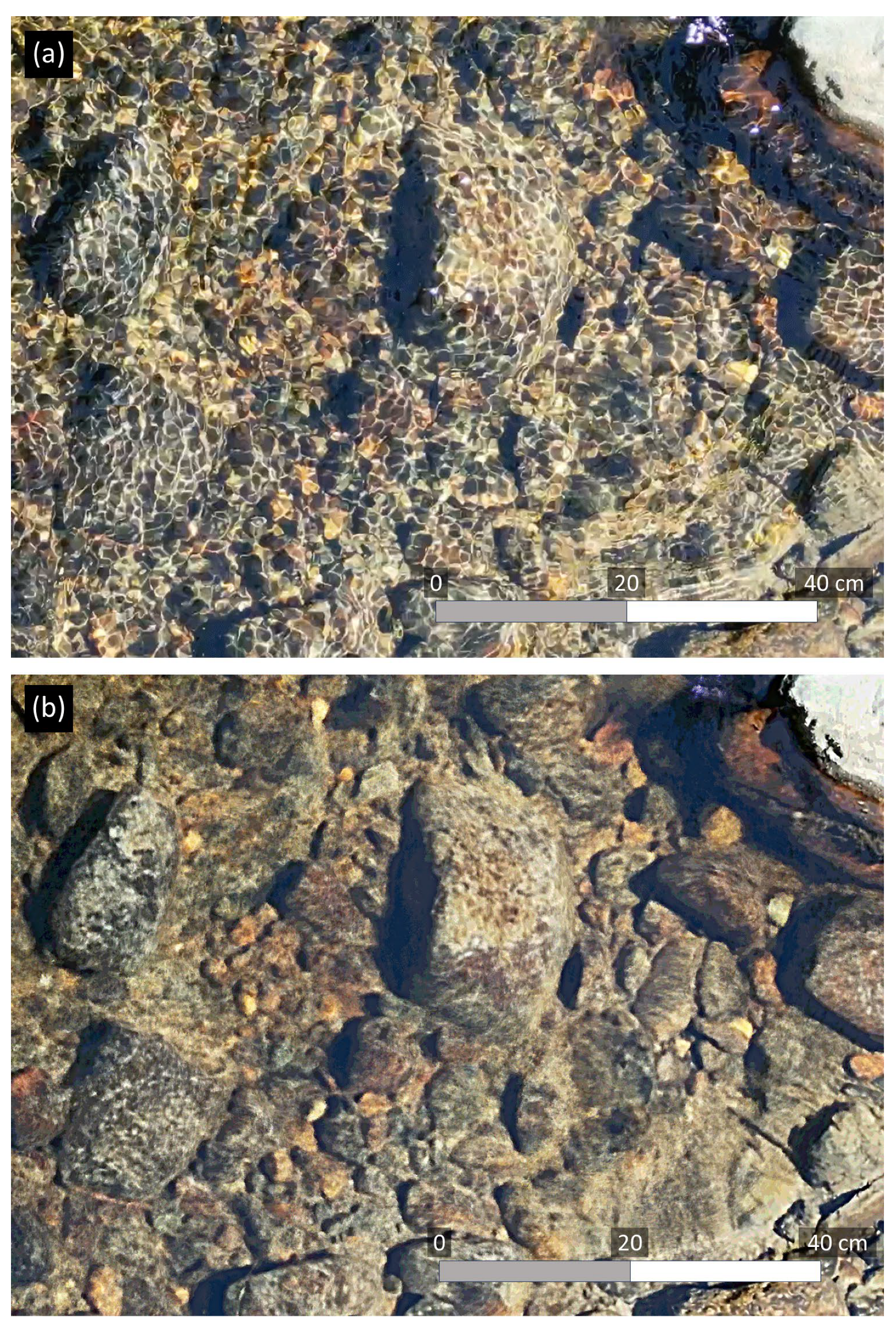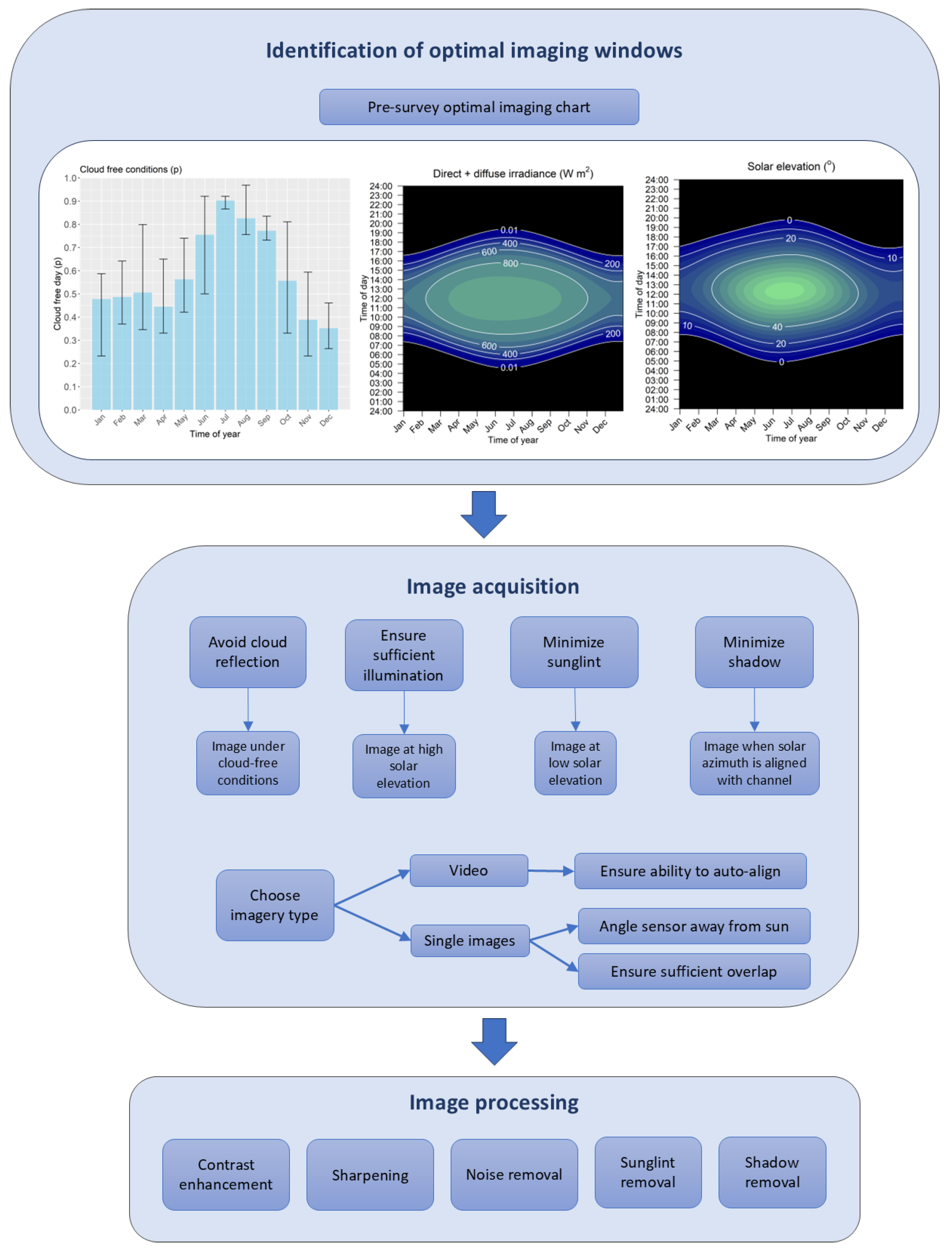1. Introduction
Obtaining information on the riverbed via remote sensing is an important component of river surveying across a range of scientific disciplines, from geomorphology and hydromorphology [
1,
2] to freshwater ecology [
3,
4]. Remote sensing can be used to provide diverse, detailed information on riverbed characteristics such as sediment composition [
5], aquatic vegetation [
6], fish spawning sites [
7,
8], and the presence of animals embedded in the substrate [
9]. Remote sensing is increasingly used for the monitoring and post facto evaluation of river restoration measures, such as the responses of riverbeds to flow regime modification, removal of barriers, and the addition of bed material [
10].
Remote sensing of riverbeds using passive optical imaging presents challenges due to a range of phenomena that affect the outgoing light signal from the bed. Firstly, it is necessary to have a sufficiently high solar elevation that incoming light is not reflected off the surface and can penetrate to the riverbed. At low solar elevations, there may be high surface reflectance (Fresnel reflectance [
11,
12]) so little light actually enters the water column. There may also be insufficient incoming light (irradiant) intensity to overcome attenuation within the water column (dependent on water column depth and water clarity) so light that does penetrate cannot be used to reveal information on the riverbed. This may pose a particular problem when imaging in high-latitude environments away from the summer solstice, which are dominated by low solar elevations or even polar night. A high enough solar elevation to provide sufficient irradiant intensity is only a first prerequisite. When imaging during overcast skies, imagery of the river channel may be dominated by reflections of overlying clouds from the water surface that completely mask the underlying riverbed. Cloud cover is typically >75% within Europe [
13], so this may be a major constraint on when the riverbed can be effectively imaged. Conversely, when imaging under cloud-free conditions, sunglint and shadows may be present. Sunglint—specular reflection from the water surface into the sensor when the angle of incidence of light on the water surface is equal to the view angle—results in optical sensors becoming saturated [
14,
15]. Sunglint on a flat water surface will likely be evident in imagery when the solar elevation is ≤half the field-of-view (FOV) of the sensor [
16]. Sunglint on a rippled surface will be evident at even lower solar elevations due to the wider range of surface angles present across the ripples. Additionally, shadows resulting from the obstruction of direct sunlight by topography and riparian vegetation [
17] make riverbed detail less visible [
18]. Other optical phenomena exist—for example, shallow water wave lensing involves ripples focusing light speckles on the bed [
19], which may further limit the ability to discern the riverbed. The effect of phenomena that hinder imaging of the riverbed vary both spatially and temporally across a range of scales, ranging temporally from seconds to intra-annually, and spatially from centimeters to the entire length of the river. Cloud cover and irradiant intensity vary regionally and throughout the year [
20]. Irradiant intensity and the prevalence of sunglint and shadow vary spatially across regions and temporally within any given day or year as a function of solar elevation and azimuth [
21,
22]. Variation in the light environment suggests that there will be an optimal window that is specific to location for remote sensing of the riverbed.
Much of the research relating to remote sensing of rivers is conducted in moderate-sized rivers (e.g., widths of 10–100 m) within well-defined floodplains [
23,
24]. Smaller streams, often in upstream tributaries and often in V-shaped and tree-lined valleys, pose a particular problem with respect to remote sensing. Firstly, many sensors have insufficient resolution to resolve smaller water bodies (such as narrow streams) without being subject to mixed pixels [
25]. Secondly, when imaging from a platform that is not perfectly following the river channel (e.g., a fixed-wing aircraft flying several hundred meters above the ground), trees may completely obstruct line-of-site to the channel. Finally, channel shading may be more significant [
26]. Steep topography in V-shaped valleys and tall riparian vegetation will cast shadows that may span the entire stream channel, something that is less prevalent for wider, lowland rivers. The result is that even when the riverbed is visible, it may be poorly illuminated, and little detail may be evident in riverbed imagery (see
Figure 1a). The issues specific to remote sensing of small water bodies mean that algorithms developed for use with larger rivers may be less effective for small streams [
27]. Unmanned aerial vehicles (UAVs) are an obvious solution to mitigating these problems. Firstly, UAV spatial resolutions are orders of magnitude higher than those of satellites or traditional aircraft, meaning the channel can be resolved while avoiding mixed pixels. Secondly, it is possible to fly along the river channel, below the tree canopy elevation, so that the riverbed is visible from the platform (see
Figure 1b). Thirdly, the flexibility of controlling UAV flight parameters allows for minimizing light phenomena that hinder successful imaging (e.g., selection of a time of day when shadows do not fall over the channel). Finally, the nature of UAV imaging allows for the application of post-processing methods that may expand the window when a riverbed can be successfully imaged. For example, if the light-induced patterns are ephemeral over the short-term—such as sunglint or wave lensing caused by moving ripples—it may be possible to remove this by acquiring video data and temporally filtering the data to remove the ephemeral phenomena [
28]. Removal of sunglint and wave lensing speckle can be a precursor to analyzing the texture on the riverbed—for instance, estimation of the size distribution of substrates [
5]—without estimates being biased by superimposed light phenomena.
Figure 1.
Example of airborne remote sensing imagery of a small, tree-lined stream (Kobberdamsbekken, Norway; see
Figure 2): (
a) aerial orthophoto; (
b) UAV imagery. In (
a), the orthophoto (0.1 m spatial resolution) was acquired from an image archive (Norwegian Mapping Agency;
www.norgeibilder.no (accessed on 23 July 2025)); the overlaid blue line shows the stream course; overlaid contours show elevation (red = lowest, orange = intermediate, yellow = highest; separation between contours = 20 m) which were derived from airborne topographic LiDAR data (Norwegian Mapping Agency;
https://hoydedata.no/LaserInnsyn2/ (accessed on 20 November 2021) using the QGIS gdal:contour algorithm. In (
b), two UAV images are shown: an image acquired under overcast conditions (acquired 11 May 2024 12:08 h; left panel) and an image acquired under cloud-free conditions (acquired 17 May 2024 12:31 h; right panel).
Figure 1.
Example of airborne remote sensing imagery of a small, tree-lined stream (Kobberdamsbekken, Norway; see
Figure 2): (
a) aerial orthophoto; (
b) UAV imagery. In (
a), the orthophoto (0.1 m spatial resolution) was acquired from an image archive (Norwegian Mapping Agency;
www.norgeibilder.no (accessed on 23 July 2025)); the overlaid blue line shows the stream course; overlaid contours show elevation (red = lowest, orange = intermediate, yellow = highest; separation between contours = 20 m) which were derived from airborne topographic LiDAR data (Norwegian Mapping Agency;
https://hoydedata.no/LaserInnsyn2/ (accessed on 20 November 2021) using the QGIS gdal:contour algorithm. In (
b), two UAV images are shown: an image acquired under overcast conditions (acquired 11 May 2024 12:08 h; left panel) and an image acquired under cloud-free conditions (acquired 17 May 2024 12:31 h; right panel).
Figure 2.
Study streams, showing locations of imaged sites (filled yellow circles).
Figure 2.
Study streams, showing locations of imaged sites (filled yellow circles).
Here, we assessed the impact of the light environment on the ability of UAVs, mounted with light-weight red–green–blue (RGB) cameras, to successfully survey the riverbed in small tree-lined streams. We firstly identified the prevalence of phenomena that hinder riverbed imaging using UAV surveys conducted in small, tree-lined streams in Norway under diverse light conditions. We then identified how big a constraint on the optimal imaging window these phenomena were for the study region. That is, we provided an indication of how limited the window would be within a cloudy and high-latitude environment where streams are often obscured by topography and riparian vegetation. We then generalized our findings to determine constraints on the optimal imaging window within a larger, regional European context. Finally, we used our findings to develop a protocol for UAV surveying of small, tree-lined streams that takes the temporally variable nature of the light environment into account.
2. Materials and Methods
2.1. UAV Surveys
To assess the prevalence of light-dependent phenomena that might hinder riverbed imaging, we examined data obtained from UAV surveys (
n = 26) conducted as part of ongoing research campaigns in six high-latitude (63.38–67.20°N) streams in Central and Northern Norway—Leirelva, Kobberdamsbekken, Baklibekken, Borråselva, Akebakken, and Mølnelva (
Figure 2;
Table 1). This post facto investigation of pre-existing survey data provided a range of ambient light conditions that are typically present when surveying small streams within Norway as part of river monitoring programs. Sites were surveyed under a range of light conditions (
Table 1), from cloud-free to overcast skies, and from low to high solar elevation. Based on estimates derived using the solar function of the solrad package (version 1.0.0) in R (
https://github.com/bbcrown/solrad, accessed on 20 May 2025) [
29,
30], average irradiant intensities (calculated as the sum of direct and diffuse irradiance) at survey times for the sites under cloud-free conditions would have ranged from <100 W m
−2 to >600 W m
−2. Irradiance on the stream channels may have been lower because of cloud presence or shadows from surrounding topography and riparian vegetation. For instance, the sites imaged in Borråselva and Baklibekken were surrounded by steep, tree-lined slopes and were strongly affected by shadow. The site imaged in the Leirelva, in contrast, was characterized by a flat riparian zone, with less tree cover so provided conditions that were largely shadow-free regardless of solar position. All imaged sites had sufficiently shallow depths (<1.5 m) that riverbeds were visible during direct sunlight on the water surface.
Surveys were performed using the off-the-shelf micro-rotor UAVs DJI Mini 2 and 3 (SZ DJI Technology Co., Ltd., Shenzhen, China) because their small size makes them appropriate for flying over narrow, tree-lined streams below the elevation of the tree canopy. The Mini 2 has a 1/2.3” CMOS sensor with a 12 MP camera, a fixed-aperture F2.8 lens with an 83° FOV, and an ISO range of 100–3200. The Mini 3 has a larger 1/1.3” CMOS sensor with a 12 MP camera, a fixed-aperture F1.7 lens with an 82.1 FOV, and an ISO range of 100–6400. Image dimensions were 4000 × 2250 (Mini 2) and 4034 × 3034 (Mini 3) pixels. Surveys varied in distance but were typically short (around 50–250 m), with the UAV flying at 5–10 m above the water surface, which provided spatial resolutions from around 0.25 to 0.5 cm. Given the short distance of individuals surveys and the prevalence of trees that acted as obstacles, surveys were conducted by manual flying rather than along pre-planned flight-lines, with line-of-site between pilot and UAV being maintained at all times, and the UAV being flown in P-GPS mode (using GNSS satellites) to aid in position control. Images were taken at 2 s intervals, with the UAV being flown slowly enough to ensure overlap between successive images to aid in construction of orthophotos. In addition to acquiring images, video surveying was used (Mini 3: video dimensions = 3840 × 2160 pixels) to investigate some light phenomena (sunglint and shallow water lensing) but was not used in the construction of orthophotos and quantification of the prevalence of light phenomena.
2.2. Determining Light-Dependent Constraints on the Optimal Imaging Window
Light-dependent constraints on the optimal imaging window for effectively observing the riverbed were determined by (1) identifying the influence of the light environment on the ability to discern the riverbed within the collected UAV imagery and (2) predicting the prevalence of these light environment conditions throughout the year and throughout the day. We identified the influence of the light environment by visual analysis of the UAV imagery. Orthophotos (resolution = 0.5 m) were constructed using Open Drone Map (ODM) [
31]. Overlapping orthophotos acquired on different dates were then compared in QGIS [
32] to identify phenomena present in one orthophoto that were absent in another. From examining the imagery, we identified issues relating to (1) cloud cover; (2) solar elevation, irradiance, and sunglint; and (3) solar position and shadow. Cloud cover manifested in imagery as water surface reflections that obscured the riverbed. The same stretch of riverbed that was visible under cloud conditions was completely obscured when the sky was overcast. Solar elevation determined irradiant intensity and therefore the visibility of the riverbed. Details visible on the riverbed under high irradiant intensity (e.g., substrates) were not visible under low intensity. Solar elevation also determined the occurrence of sunglint, manifested as small patches of saturated-pixels on the sun-facing side of ripples. Solar position affected the occurrence of shadows, manifested as dark patches beneath which the riverbed was less visible. We predicted the prevalence of these conditions for the study sites as follows:
Cloud cover. We determined the prevalence of cloud cover at the study sites from the Cloud Fraction dataset [
33] of the NASA Earth Observations portal [
34]. This dataset is based on Aqua/MODIS satellite data and provides mean cloud cover fraction per pixel (0.1° spatial resolution) per month. Using data from 2016–2019, we calculated the mean cloud cover for each month at each survey site.
Solar elevation, irradiance and sunglint. We calculated solar elevation and total irradiant intensity (direct + diffuse) using the solrad package (version 1.0.0) in R for a latitude of 63°N (the average of the survey sites) as a function of time of year and time of day. By comparison of riverbed visibility in our UAV imagery and corresponding irradiant intensities, we were able to identify intra-annual and intra-diurnal constraints on when there would be sufficient irradiant intensity for optimal imaging. With respect to predicting the prevalence of sunglint, we used information on when sunglint was present in the UAV surveys to establish an upper solar elevation threshold for avoidance of sunglint on ripples at 20°. Based on the sensor FOV, we established an upper solar elevation threshold for avoidance of sunglint on a flat surface at 40°. Very low solar elevations lead to high reflectance from the water surface (Fresnel reflectance), so we established a lower solar elevation threshold at 10°. Thus, an optimal window for avoiding sunglint and Fresnel reflectance would lie between 10 and 20° for a rippled surface and 10 and 40° for a flat surface. We then mapped these conditions as a function of time of year and time of day for the average position of the survey sites (63°N).
Solar position and shadow. To examine the prevalence of shadow on the stream channels, we predicted shadow positions for the survey sites under a range of solar elevations and azimuths. First, we predicted solar elevations and azimuths for two dates—21 June (summer solstice) and 22 September (autumn equinox) for each of the streams using the solrad package. Second, we estimated shadow positions for each solar elevation and azimuth by applying a shade prediction algorithm (R function insol::doshade) to a 1 m resolution topographic LiDAR-derived digital surface model (DSM), which showed the combined elevation of surrounding topography and riparian vegetation (Norwegian Mapping Agency, Hønefoss, Norway) [
35]. Third, the proportion of the length of each stream that was under shadow for each solar elevation and azimuth was estimated from the overlap between predicted shadow locations and the stream course as derived from a dataset on Norwegian rivers (NVE Elvenett/ELVIS) [
36].
2.3. Determining Regional Patterns of the Optimal Imaging Window Across Europe
Based on our findings for light-dependent constraints on optimal imaging for the survey sites, we predicted temporal and regional patterns in the optimal imaging window across Europe. We chose this region because it covers an expansive geographical area with a range of light environment conditions in terms of cloud cover, irradiance, and propensity to sunglint. First, we used NASA’s Cloud Fraction dataset to determine the number of cloud-free days throughout Europe, year-round, and separately for summer and winter. Secondly, we determined the number of hours per day as a function of time of year and latitude when irradiance levels would be great enough to allow effective imaging of the riverbed, using >100 W m−2 as an absolute minimum threshold for imaging and >500 W m−2 as a more typical minimum threshold. Finally, we determined the number of hours per day as a function of time of year and latitude when solar elevation would be suitable for avoiding sunglint: (1) 10–40° and (2) 10–20°. The first case (10–40°) provided a window where solar elevation was high enough to minimize Fresnel reflectance but low enough to avoid sunglint on a flat surface for a down-looking sensor with a FOV of 80°. The second case (10–20°) provided an even more restricted window, where sunglint on rippled surfaces would likely be absent.
4. Discussion
Effective optical remote sensing of the riverbed in small, tree-lined streams is difficult due to the requirement to obtain a suitable light environment. Using UAV surveys conducted under a range of light conditions, we found imagery is particularly susceptible to reflection of the overlying cloud layer at the water surface, as well as the presence of sunglint and shadow. We calculated that avoiding adverse light conditions would greatly limit the optimal imaging window, although the manner in which this restriction occurred would vary both regionally across Europe and according to local site characteristics. In the following sections, we discuss constraints on the optimal window for surveying the riverbed in small, tree-lined streams. We then discuss the potential for expanding the optimal imaging window via careful image acquisition and image processing. Building on this, we present a protocol for optimal imaging that takes the light environment into account.
4.1. Constraints on the Optimal Imaging Window
The optimal window for imaging the riverbed is dependent on regional and local variation in a range of factors affecting the light environment. Based on regional changes in cloud cover and solar elevation, European rivers can be placed in two classes: northern and southern.
Northern European rivers (e.g., latitudes > 55°N) are characterized by high cloud cover throughout the year, such that cloud-free conditions for imaging only occur on around 25–30% of days within the year. Low solar elevations in winter lead to short-day lengths, as well as to low irradiant intensities even at noon. Thus, at northern latitudes, the optimal imaging window may be constrained within the year to exclude winter months. Conversely, the optimal imaging window within a day during summer months will be long due to the long day length. Although the generally low solar elevations encountered in northern latitudes lead to low irradiant intensity, they make the river surface less prone to sunglint, so it may not be necessary to interrupt imaging around noon.
Southern European rivers (e.g., latitudes < 55°N) are characterized by less cloud cover throughout the year, such that cloud-free conditions for imaging exist on more than two-thirds of days throughout the year. Conditions are cloudier in winter than summer, but imaging is still possible in winter on around one-third of days. The less variable day length throughout the year does not greatly restrict the daytime imaging window in winter. However, higher solar elevations make water surfaces more prone to sunglint so the optimal imaging window within the day during summer may be greatly restricted. There is, however, the potential to expand this window with careful image acquisition and processing (see
Section 4.2).
Optimal windows will further be reduced by the presence of shadows. This restriction is much more locally dependent than either the requirements of cloud-free conditions or optimal solar elevations and will depend on both topography and riparian vegetation, both of which will vary locally. For example, north–south-aligned rivers will be less affected by shadow than east–west-aligned rivers when imaging around noon. However, for a given alignment, topography, and vegetation cover, northern European rivers will be more affected than southern European rivers due to the generally lower solar elevations in northern latitudes.
4.2. Expanding the Optimal Imaging Window
Low irradiant intensities are a particular problem for imaging rivers in northern locations, particularly when imaging away from the summer solstice, because riverbed imagery will be dark and relatively noisy. Additionally, low solar elevations in these northern locations can cause problems with achieving an effective sun–target geometry [
37]. The imaging window can be expanded to include darker ambient light conditions via image post-processing: for example, through contrast enhancement and removal of noise using bilateral filters [
38].
Sunglint is a particular problem for southern locations. Avoiding sunglint may reduce the daily imaging window in summer to only a few hours in the early morning and late afternoon. Correctly orienting the sensor, use of polarizing filters, or image processing may avoid or minimize the presence of sunglint and thus expand the optimal imaging window.
- (1)
Orienting the sensor so that it only captures areas unaffected by sunglint means that imagery will be free of sunglint and avoids the need for further filtering. Several studies have achieved this by orienting the sensor away from the solar azimuth angle [
39,
40]. While this may reduce the presence of sunglint, the requirement to maintain a specific sensor orientation adds to surveying effort and may pose problems for creation of structure-from-motion orthophotos, which require a range of view angles for effective creation.
- (2)
Polarizing filters have been recommended for minimizing surface glare [
37]. However, polarizing filters are not without limitations when used on UAVs [
39]. The effectiveness of polarization filters is dependent on the sun–target–sensor geometry. Polarization is strongest around Brewster’s angle for water, 53–57° from the sun, and is minimal at nadir for a down-viewing sensor. The strength of polarization will vary across the image depending on the view-angle to the pixel, so the filtering of the polarized signal will vary across the image. The problem is compounded for rippled surfaces that cause polarization to become very variable across small spatial scales. This means that polarizing filters may actually add an artefact to imagery that may possibly even hinder remote sensing of the riverbed. We chose not to use polarizing filters because our preliminary work with a circular polarizer/linear (CPL) filter proved to be ineffective.
- (3)
A wide range of image processing approaches have been used to minimize sunglint present in imagery. The simplest approach is cropping single images to remove areas affected by sunglint, allowing for subsequent mosaicking of cropped images to cover extended areas of the channel [
41]. More advanced approaches are available, falling into two main categories. Firstly, if multi-spectra data are available, it is possible to use reflectances in different channels (particularly NIR) to adjust values in pixels affected by sunglint [
42,
43]. Alternatively, if multiple images of the same area are available (e.g., from a video acquired by the UAV), it is possible to identify and mask pixels affected by sunglint and fill in masked areas using data from other images. This can be done by various techniques such as stacking [
28] or optical-flow-based pixel propagation [
44].
Shallow water wave lensing (the focusing of light refracting through surface waves into a speckle pattern on the water body bed in shallow waters) is found in both northern and southern locations, and was evident beneath ripples in the shallow, northern streams of the current study under direct sunlight. There has been less research into removal of wave-lensing than removal of sunglint, but we have found that application of the stacking approach originally developed for removal of sunglint [
28] can be used for removal of wave-focused speckle (see example in
Figure 6). We have found, however, that this method requires careful control in surveying approach and is not always effective. Firstly, surveying effort is high, typically requiring surveying from a fixed position and ensuring the presence of a static land surface in the video to enable auto-alignment. Secondly, the stacking of information from multiple frames results in smoothing of riverbed detail due to imperfections in alignment and changes in geometric distortion between images, and it is therefore necessary to find the correct balance between removing wave-focused speckle and over-smoothing of the riverbed detail.
Shadows also pose a problem for both northern and southern locations. Imaging the river during a range of solar positions may allow for selective merging of shadow-free areas and increase the proportion of the river that is shadow-free in the constructed, composite image. Alternatively, shadows in individual images may be identified and filtered. There is ongoing research on shadow removal from UAV imagery [
45,
46]. This research has focused on terrestrial applications, but in principle, could be applied to water surfaces.
4.3. A Protocol for Optimal Riverbed Remote Sensing Using UAVs
The advantage of UAV remote sensing with respect to imaging riverbeds in small, tree-lined streams is that it offers greater flexibility over (1)
when imaging is done (allowing selection of optimal light environments); (2)
how the imaging is done (e.g., allowing selection of an optimal view angle with respect to the solar position); and (3) the
type of data obtained (allowing for post-processing of collected imagery). This flexibility can be incorporated into a protocol so that UAV surveying can collect the best information possible. This should involve (1) identification of optimal windows for surveying prior to the survey attempt; (2) image acquisition under the best possible light conditions; and (3) post-processing of acquired imagery (
Figure 7).
4.3.1. Identification of Optimal Imaging Windows
Optimal imaging windows—both with respect to time of year and time of day—should be identified pre-survey to ensure the highest probability of success when the surveying is conducted. We recommend that a pre-survey optimal imaging chart is created for the survey location in question, describing historical patterns of cloud cover, solar elevation, and irradiance. If data on surface elevation around the site are available, we recommend that the shadow environment is estimated pre-survey for a range of solar positions. This approach enables gauging of the balance between conflicting light environment requirements: for instance, the requirement to maintain a high enough irradiant intensity to observe the riverbed while at the same time minimizing sunglint or shadow. In addition to identifying optimal imaging windows with respect to the light environment, it is also useful at this stage to identify the historic flow patterns within the stream which may impact riverbed visibility: for example, high discharges lead to more white water/foam on the surface and increased turbidity in the water column, affecting riverbed visibility.
Identification of optimal imaging windows can be used to (1) plan survey times for investigations that can be conducted irrespective of time of year and (2) assess the merits of using UAV remote sensing when there is a requirement to obtain information at a specific time of year. In the former case, many investigations can be conducted at any date within a year—for example, investigation of stable riverbed substrates. Here, it is prudent to select the optimal imaging time within the year to obtain the best data. In the latter case, some investigations may target time-specific phenomena. For example, salmon redd (i.e., spawning site) formation occurs in autumn, when solar elevations are low, and skies may be prone to cloud cover. Assessing the likelihood of successfully imaging the riverbed under such conditions can be used in determining whether UAV remote sensing is suitable and/or the resources that should be assigned to it.
4.3.2. Image Acquisition
After identification of optimal imaging windows, surveys can be planned so that imagery is obtained at a time when the likelihood of adverse light conditions are minimized. Based on site location, calculated solar positions can be used to ensure surveying occurs at sufficient irradiance levels, with minimal sunglint and shadow. This will influence the time of optimal imaging, both within the year (e.g., winter may be unsuitable for northern locations) and within the day (noon at summer may be unsuitable for southern locations). Attention should also be paid to how river orientation with respect to surrounding topography and riparian vegetation impacts on the light environment (see [
26]) so that surveys are acquired at an appropriate solar azimuth. In the days leading up to surveying, short-term weather forecasts can be used to focus planned surveys towards days or hours when cloud-free conditions are expected.
The manner in which imagery is acquired should also take the light environment into account. If the solar elevation at imaging is likely to lead to sunglint, mitigation methods should be employed such as (1) off-nadir viewing; (2) ensuring that there is sufficient overlap between successive images to enable removal of sunglint-affected areas followed by image splicing; or (3) acquisition of video to allow for temporal filtering.
4.3.3. Image Processing
The extent to which image processing is required will depend on (1) the degree to which light-dependent phenomena (e.g., sunglint, shallow water wave lensing, ripples, shadows) that obscure the riverbed are present within the imagery and (2) the objectives of the investigation. Careful selection of the time of imaging may minimize the requirement for image processing, but some phenomena may inevitably be present (e.g., sunglint on ripples in southern rivers during summer). Depending on investigation objectives, it may not always be necessary to apply image processing. For example, a qualitative investigation of dominant substrate types may be possible even if there is patchy sunglint; in contrast, a quantitative measurement of the substrate size distribution may require processing to remove the sunglint. When required, a wide variety of image processing methods exist (see examples in
Section 4.2), and researchers should plan for their use as part of the overall mission planning. This area is rapidly developing—in particular, machine learning approaches [
47,
48,
49]—but researchers should take into account that they are dealing with a particularly complicated light environment, and that many of the techniques applied to wide, open low-land rivers may be less effective in small, more constrained streams.
UAVs are increasingly being incorporated as tools in river monitoring programs [
50]. UAV imagery is potentially useful for providing a synoptic picture that can be integrated into more traditional survey approaches (on-site monitoring gauges, manual field measurements), but there is the danger of collecting sub-par UAV imagery if surveys are not carefully planned. Survey flights should be planned with respect to the light environment of the site in question, rather than conducted haphazardly. For monitoring riverbeds in the type of stream shown in the current study (small, tree-lined streams in a cloudy high-latitude region), UAV flights might have rules governing the window when surveys can be conducted: (1) survey only when skies are not overcast to minimize reflection of clouds from the channel surface; (2) survey only from spring to autumn to ensure sufficient illumination; (3) survey away from noon to minimize sunglint on ripples; and (4) survey only when solar azimuth is aligned with the river to minimize shadow. These rules can be used to predict likely optimal windows for surveying, based on historical data or models, which can be further refined in real-time, depending on near-future forecasts.
